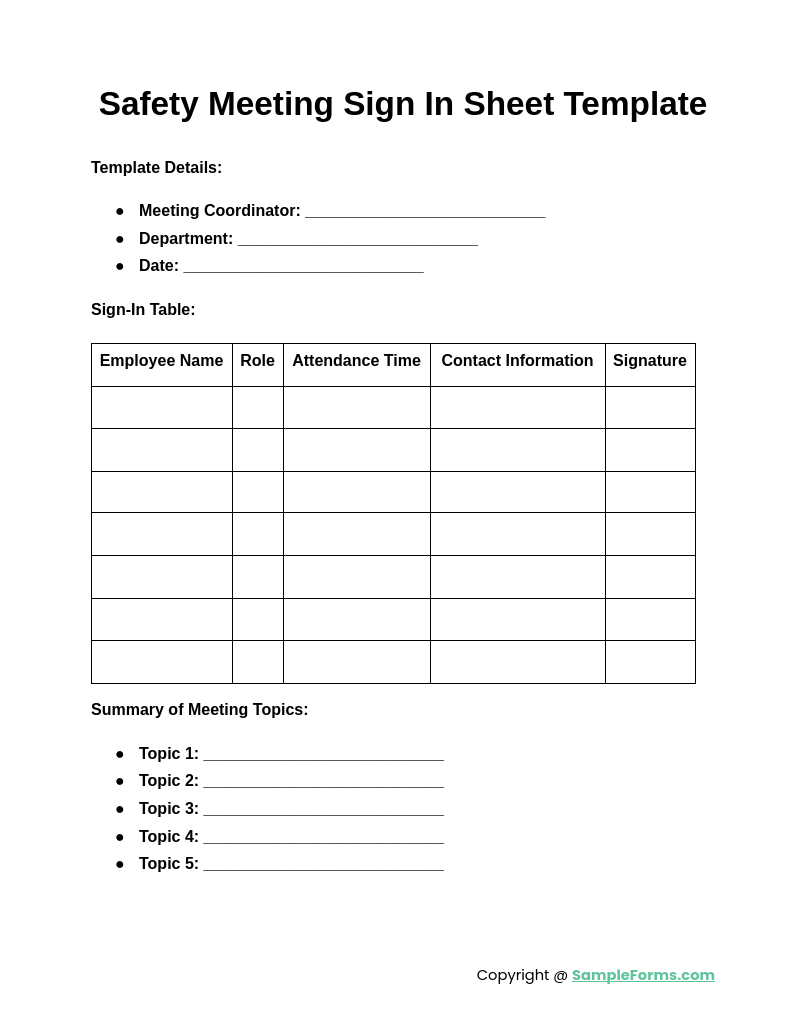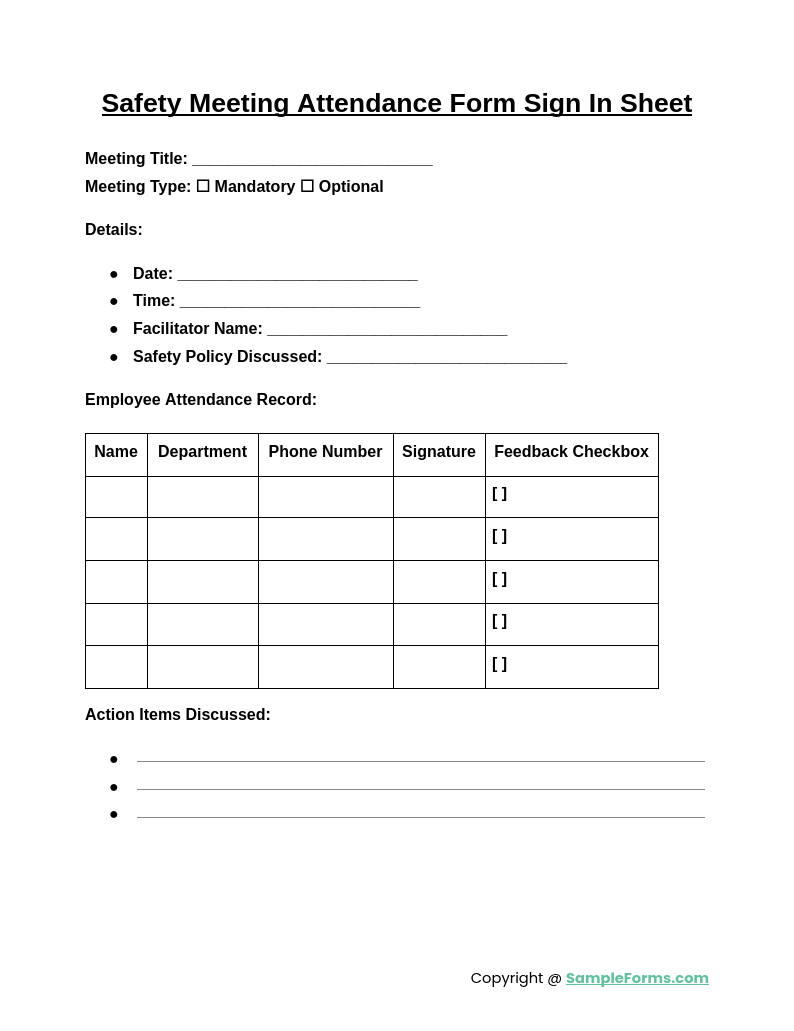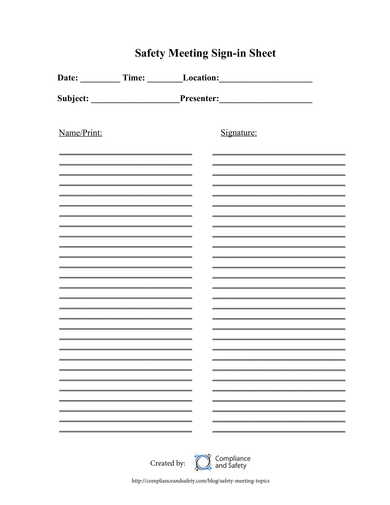A Safety Meeting Sign In Sheet is an essential tool for recording attendance during workplace safety discussions. Combined with a Safety Meeting Form, it ensures compliance with safety protocols and tracks participant engagement. Similar to a Sign In Sign Up Sheet, it simplifies documentation, encouraging accountability and fostering a culture of safety. This guide offers examples, templates, and tips to craft effective sheets tailored for various industries. Whether for daily briefings or specialized safety training, a well-structured sign-in sheet guarantees seamless record-keeping and reinforces your commitment to workplace safety and efficiency.

Download Safety Meeting Sign In Sheet Bundle
What is Safety Meeting Sign In Sheet?
A safety meeting sign-in sheet is a type of document that companies use as an attendance form for the participants and attendees of a scheduled safety meeting. The name of the participating employees and staff members or workers of the company will be enlisted in the form along with their signatures and the date when they arrived at the meeting. In addition, their role and job position in the company can also be included in the sign-in sheet as well as their department assignments if preferred and needed by the company.
Safety Meeting Sign-In Sheet Format
Meeting Title: [Insert Meeting Title]
Facilitator Name: [Name of Person Leading the Meeting]
Date and Time: [Insert Date and Start/End Time]
Location: [Insert Venue/Location of the Meeting]
Meeting Agenda:
- List the key topics to be discussed (e.g., workplace hazards, recent incidents, updates to safety procedures).
Participant Information Section:
Provide space for attendees to fill in the following:
- Full Name: _____________________________
- Department/Position: _____________________________
- Contact Number/Email: _____________________________
- Signature: _____________________________
Action Points:
Include a section for noting actions assigned during the meeting.
Facilitator’s Closing Remarks:
Provide space for the facilitator to summarize the meeting outcomes or action items.
Employee Safety Meeting Sign In Sheet

An Employee Safety Meeting Sign In Sheet tracks employee participation in safety discussions. Similar to an Employee Sign In Sheet, it ensures accountability, promoting workplace safety standards and compliance. Use this sheet for accurate attendance records.
Weekly Safety Meeting Sign In Sheet

A Weekly Safety Meeting Sign In Sheet records attendees for regular safety discussions. Like a Bathroom Sign Out Sheet, it maintains order and structured documentation for workplace safety training and awareness programs.
Safety Meeting Sign In Sheet Template

A Safety Meeting Sign In Sheet Template simplifies attendance recording. Comparable to a Real Estate Open House Sign In Sheet, it offers customizable formats for tracking participation in safety sessions efficiently and effectively.
Safety Meeting Attendance Form Sign In Sheet

A Safety Meeting Attendance Form Sign In Sheet ensures proper attendance documentation during safety meetings. Similar to a Balance Sheet Form, it systematically records participant details, fostering organization and compliance in workplace safety management.
Browse More Safety Meeting Sign-In Sheets
Safety Meeting Sign-In Sheet Sample
Safety Meeting Sign-In Sheet in DOC
Basic Safety Meeting Sign-In Sheet
Safety Meeting Agenda Sign-In Sheet
Safety Meeting Sign-In Roster Sheet
Safety Training-Meeting Sign-In Sheet
Weekly Safety Meeting Sign-In Sheet
What do you say in a safety meeting?
Effective safety meetings require concise communication about risks and protocols. Use relatable scenarios to engage participants and ensure actionable takeaways.
- Start with an Icebreaker: Welcome attendees warmly, like a Visitor Sign In Out Sheet, to create an inclusive environment.
- Discuss Recent Incidents: Address past incidents and their resolution for better awareness.
- Highlight Key Risks: Focus on immediate hazards relevant to the workplace.
- Share Safety Updates: Provide updates on regulations or new safety measures.
- Encourage Questions: Allow open dialogue to clarify doubts and promote collaboration.
What should be in a safety committee meeting?
A safety committee meeting emphasizes collaborative problem-solving for workplace hazards and ensures compliance with safety standards.
- Attendance Documentation: Record attendees with tools like a Parent Sign In Sheet for accountability.
- Review Old Business: Discuss previous action items to track progress.
- Address New Hazards: Introduce newly identified risks and their mitigation plans.
- Plan Training Sessions: Propose future safety training schedules.
- Assign Action Items: Distribute tasks to resolve pending safety concerns.
What are the 5 steps to conducting a safety meeting?
A systematic approach to safety meetings ensures meaningful outcomes. Each step builds towards improving workplace safety standards.
- Prepare the Agenda: Design a focused agenda to streamline discussions, similar to filling out a Daycare Sign In Sheet for organization.
- Gather Resources: Include safety manuals, visual aids, or digital tools for effective engagement.
- Encourage Participation: Create opportunities for employees to voice their concerns or suggestions.
- Document Discussions: Maintain detailed minutes for future reference.
- Evaluate the Meeting: Collect feedback to refine the process.
What are the 7 step safety rules?
Seven critical safety rules ensure a robust foundation for workplace hazard prevention and response.
- Identify Hazards: Use tools like a Student Sign In Sheet to engage employees in hazard identification.
- Assess Risks: Determine the severity and probability of risks.
- Control Measures: Implement protective protocols to mitigate risks.
- Communicate Safety Policies: Clearly articulate guidelines and procedures.
- Train Employees: Conduct regular workshops to enhance safety knowledge.
- Monitor Compliance: Enforce rules through frequent inspections and audits.
- Update Procedures: Regularly revise protocols to adapt to new challenges.
How do you set up a safety meeting?
Setting up an effective safety meeting involves planning, engagement, and clear communication for positive outcomes.
- Choose a Suitable Time: Ensure maximum attendance by accommodating schedules, like a Volunteer Sign In Sheet Form organizes participants.
- Select Relevant Topics: Tailor the agenda to current risks or incidents.
- Prepare Visual Aids: Use charts, videos, or handouts for clarity.
- Set Objectives: Define measurable outcomes for the meeting.
- Gather Feedback: Encourage participants to share thoughts for continuous improvement.
Does OSHA require signatures for safety meetings?
Yes, OSHA encourages maintaining attendance records for safety meetings, often documented with a Patient Sign In Sheet, ensuring compliance and accountability.
How to make a safety meeting fun?
Incorporate interactive activities, such as quizzes, role-playing scenarios, and real-world examples, structured with tools like an Employee Time Sheet for engagement tracking.
What are some good safety slogans?
“Safety first, last, and always” or “Think safe, work safe, stay safe” are effective slogans promoting workplace safety awareness. You may also see Safety Risk Assessment Form
How to structure a safety meeting?
Start with key updates, discuss incidents, review protocols, and end with Q&A, similar to organizing a Guest Attendance Sign In Sheet for clarity.
What does a safety meeting look like?
Safety meetings involve presentations, discussions on hazards, and interactive sessions, often supported by documentation like a Safety Assessment Form for participant records.
What is the golden rule of safety?
The golden rule of safety emphasizes proactive risk identification and prevention, reinforced by tools like a Construction Safety Form to standardize processes.
How long should a safety meeting last?
Safety meetings typically last 20–30 minutes, balancing efficiency and thoroughness, similar to a Job Safety Observation Form for concise data recording.
When should safety meetings be held?
Safety meetings should occur regularly, such as weekly or monthly, ensuring timely discussions, and can include tools like a Safety Audit Form for review.
What are the three C’s of safety?
The three C’s—communication, cooperation, and compliance—ensure effective safety protocols, often documented using a Job Safety Analysis Form for clarity.
How often should a company have a safety meeting?
Companies should hold safety meetings monthly or as needed, tracking participation through tools like a Safety Acknowledgment Form to ensure adherence.
A Safety Meeting Sign In Sheet is crucial for documenting attendance and ensuring engagement in safety sessions. Similar to a Meeting Evaluation Form, it fosters accountability and helps maintain a transparent and secure work environment.
Related Posts Here
-
FREE 16+ Ticket Order Forms in PDF | MS Word | Excel
-
Employee Dress Code Policy Form
-
Rental History Form
-
Advertising Contract Form
-
Service Agreement Form
-
Income Statement Form
-
Accident Statement Form
-
Performance Review Form
-
Event Contract Form
-
Contest Registration Form
-
Waiting List Form
-
Restaurant Schedule Form
-
Mobile Home Bill of Sale
-
Landlord Consent Form
-
60-Day Notice to Vacate Form









